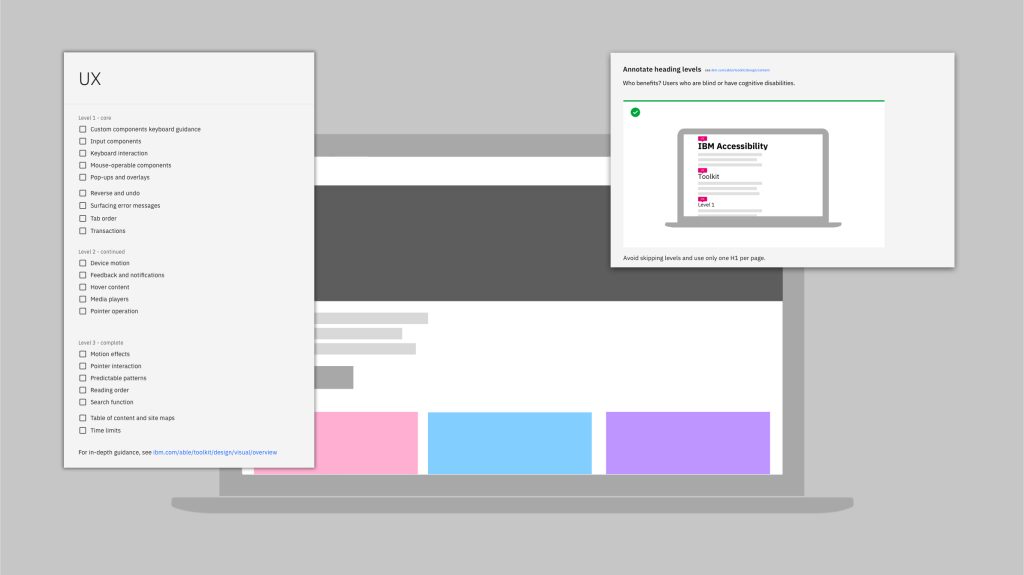Accessibility offers the Ultimate User Experience

by Alexandra Grossi | IBM, December 3, 2021
Today is International Persons with Disabilities Day, which provides an opportunity to further reflect on IBM’s contributions to accessibility and inclusivity when it comes to the ever-evolving world of technology and design.
I am the Lead UX Designer for IBM Accessibility. I am an inclusive design advocate. I also happen to be a profoundly deaf, bilateral cochlear implant wearer.
This year, my team and I have been devising tools to educate and enable tech team designers so that they can make their work more accessible while also easily applying best practices. One such tool is an Accessibility Design Kit that works with IBM’s current design tools (available on Sketch, coming soon to Figma). With this tool, we offer task lists with bite-sized guidance, as well as annotation assets that allow designers to clearly communicate accessibility specs to developers and other people on their team.
Design is a field that has always had to pivot and grow. Unfortunately, accessibility and inclusive design are relatively new concepts within mainstream design and have historically been excluded from formal design education.
User-Centered Design is widely accepted as the best approach in designing for technology. The first principle of IBM Design Thinking is “Focus on user outcomes.” When we fail to incorporate accessibility best practices, we miss the mark on this crucial component that drives IBM Design. Being accessible offers the ultimate user experience.
According to the CDC, approximately 25% of adults in the United States have a disability. If one in four adults — 61 million Americans — have a disability, the design field can no longer claim ignorance. The time to adopt accessibility best practices is now. No matter where designers are in their careers or education — inclusive design needs to be integrated into their practices immediately. The resources we offer at IBM Accessibility can help.
The fight for accessibility often rests on many tired truisms. As someone who has been deaf since birth, the most irksome of all the cliches is this: “Just remember, you could become disabled one day.” This assumes we only care about accessibility if it might somehow affect us personally. Empathy is not only an essential element to creating good design, it’s a defining characteristic of humanity. Designers must start designing for inclusion, not because it’s good for the bottom line, or fosters innovation, (though both are true), but because designers should not choose which users can participate. After all, it’s not Selective-User-Centered-Design.
If we can move past “why accessibility is important,” we can start to focus on “how to design accessible products.” I want to address some common misconceptions among designers that often serve as a blocker in considering accessibility:
Myth: Accessible design is just color and contrast
Color and contrast are important, but these do not cover everything in designing for accessibility. Designers must consider all the ways users operate. Such as non-visual elements, which are too often neglected and left to chance.
One example is non-visible text read by assistive technology that blind or visually impaired users need to be able to utilize a website or program. When this is overlooked, keyboard navigation is less accessible. Design teams must consider how users who don’t use a mouse can navigate their spaces.
Myth: Accessibility is too expensive
Starting a project with accessibility in mind saves (and earns) more money in the long run. Making your product compliant only gets expensive and cumbersome when it is left until the end of a product cycle and things have to be redone hastily.
This is what we mean when we talk about “shifting accessibility left.” We can reduce the responsibility of applying accessibility considerations from the developers when designers incorporate best practices into their processes at the beginning of a project. Including accessibility in your iterations also helps make sure your team doesn’t suddenly have to triage to meet accessibility compliance. When this happens design changes are often rushed, require more labor, and can thus be more expensive. This ultimately makes for a poorer user experience — clearly not the goal.
Myth: Using a design system automatically makes your designs accessible
While a design system such as Carbon can be very helpful in creating an accessible framework, no system can automatically make all of your designs accessible. Additionally, it’s very easy to render components inaccessible if you customize pieces without understanding the full scope of accessibility.
Myth: Accessibility is too hard
Becoming an accessibility-minded designer can seem challenging in the beginning. Like every other new skill, it takes time, practice, and dedication. Over time, it gets easier and becomes second nature. You may stumble — you might even commit an embarrassing blunder or two — but I assure you, your products and users will benefit so much from it.
And remember, you’re not alone in this. When you work with a team, everybody plays an active role. Our toolkit breaks it down for you, so you can learn together, making the process less intimidating.
And so, in honor of International Persons with Disabilities Day, I invite you to be brave and step into the world of accessibility and inclusive design with an open heart and mind. Not only will you pass compliance, but your user base (and revenue) will grow, and you’ll find innovative solutions you may not have considered before. If you expand User-Centered Design to include all users, you’ll succeed in designing the ultimate user experience.
About This Article:
A Life Worth Living has copied the content of this article under fair use in order to preserve as a post in our resource library for preservation in accessible format. Explicit permission pending.
Link to Original Article: https://www.ibm.com/blogs/age-and-ability/2021/12/03/accessibility-offers-the-ultimate-user-experience/

